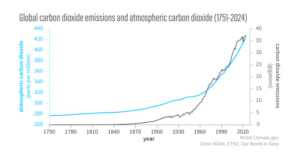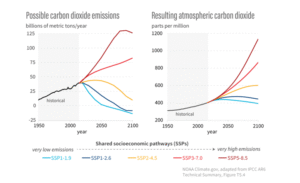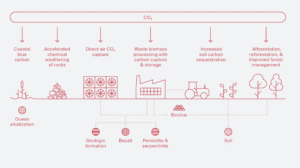scroll

Climate change is a long game measured in carbon. Since 1750, human activity has released an estimated 1.5 trillion tonnes of CO₂ into the atmosphere. The total continues to climb by more than 1,000 tonnes every second—roughly 40 gigatonnes each year. At that pace, the carbon budget for 1.5°C will be spent in just a few years. Each additional tonne of carbon in the atmosphere thickens the blanket of greenhouse gases that traps heat, destabilizes weather, and fuels warming for generations.
Securing a livable future therefore rests on two inseparable pillars: cutting emissions as quickly as possible and removing CO₂ to balance what cannot yet be eliminated. Reductions slow the flow of new pollution; carbon dioxide removals address both stubborn residuals and the vast stock of carbon already aloft. The question isn’t whether removals are “nice to have.” It’s whether we want the math to work. Without removals, net zero is unattainable and net negative even further out of reach. With them, it becomes a credible path to repairing the damage of the past and building stability for the future.
The issue is not that Earth has “too much” carbon—carbon is constant on this planet—but that we have disrupted where it is stored. Fossil fuels such as coal and oil contain the carbon from millions of years of photosynthesis. Burning them has shifted these reserves from underground into the atmosphere in just a few hundred years.
The last time atmospheric CO₂ levels were this high (above 400 parts per million (ppm)) was during the Pliocene Epoch, around 3 to 5 million years ago. At that time, global average temperatures were 2–3 °C warmer, the Arctic was largely ice-free in summer, and sea levels stood 15–25 meters higher (enough to submerge large parts of today’s coastal cities, including New York, London, Shanghai, and Mumbai). This geological record provides an important reference point for understanding how Earth’s systems respond to elevated carbon levels. Today, rising concentrations are already linked to more extreme heatwaves, higher seas, and shifting rainfall patterns that affect food and water security.

Figure 1: Atmospheric CO₂ has climbed from about 278 ppm in 1750 to 422.7 ppm in May 2024—an increase that included a record one-year jump of 3.75 ppm in 2024. Source: NOAA.
Explore NASA’s interactive graphics to dig deeper into atmospheric CO₂.
Even with the most ambitious decarbonization strategies, some emissions will remain. Sectors such as aviation, shipping, cement, steel, and agriculture are often called “hard to abate” because eliminating their emissions entirely is technically difficult, prohibitively expensive, or both. For example, cement production releases CO₂ not only from the energy used to heat kilns but also from the chemical reaction that turns limestone into clinker. With 100% renewable energy, those “process emissions” persist. Similarly, aviation depends on high-density fuels, and while alternatives are advancing, fully eliminating emissions from long-haul flights remains out of reach for now.
Arithmetic is blunt: whatever emissions remain must be counterbalanced by removals, or the net-zero equation does not balance. And it is not only today’s emissions that matter. The carbon already accumulated in the atmosphere continues to exert a warming effect for centuries. To stabilize the climate in the long run, carbon dioxide removal (CDR) must therefore do two things: neutralize residual emissions from these hard-to-abate sectors and help draw down legacy emissions—the build-up of past pollution that locks in tomorrow’s risks.

Figure 2: Projected global CO₂ emissions (left) and resulting atmospheric concentrations (right) through 2100. Even under the most ambitious emission-reduction scenarios, durable carbon removal remains essential to a climate-safe future. Source: NOAA.
Carbon dioxide removal (CDR) refers to the intentional removal of CO₂ from the atmosphere and its storage in land, marine, or geological systems. Approaches are often grouped into three categories: nature-based, hybrid, and engineered. Each differs in scale, durability, cost, and co-benefits.
Nature based solutions (NbS) build on ecosystems’ ability to absorb and store carbon. Planting and protecting forests, improving agricultural practices, and restoring wetlands, mangroves, and seagrass beds all enhance natural carbon sinks while delivering ecological and community benefits.
Hybrid based solutions combine natural processes with technological enhancements. Biochar stabilizes carbon from biomass and stores it in soils for centuries, while enhanced rock weathering and ocean alkalinity speed up mineral reactions that lock CO₂ into durable forms.
Engineered solutions rely on technology to capture CO₂ directly and store it underground or in stable minerals. Direct Air Capture with Storage (DACS) scrubs CO₂ from ambient air, Bioenergy with Carbon Capture and Storage (BECCS) couples biomass energy with storage, and mineralization converts CO₂ into solid carbonates.
No single approach is sufficient on its own. Together, they form a portfolio that complements rapid emission cuts. If mitigation is turning off the tap, high-quality CDR is mopping up the spill.

Figure 3: Select CDR approaches from the CDR Primer, Chapter 2: “The Case for Carbon Dioxide Removal.”
Scaling carbon dioxide removal (CDR) depends on integrity. Whatever the method (nature-based, hybrid, or engineered) the same principles must apply: credible baselines, conservative accounting, transparent monitoring, and enforceable safeguards. Without these, removals risk undermining trust in net-zero strategies and slowing the flow of capital into solutions the world urgently needs.
Governance frameworks are beginning to set clearer guardrails. The Integrity Council for the Voluntary Carbon Market (ICVCM) has introduced Core Carbon Principles for supply, while the Voluntary Carbon Markets Integrity Initiative (VCMI) provides guidance for buyers. Combined with independent verification, these initiatives are laying the foundation for a market that can scale with credibility.
Each tonne of CO₂ removed lowers the long tail of risk, from sea-level rise to ecosystem collapse, while buying time for vulnerable communities already living on the frontlines of climate change. Yet every year of delay tightens the carbon budget and increases the burden on future generations. The longer action is postponed, the more carbon accumulates, and the harder it becomes to balance the ledger.
With integrity frameworks emerging and technologies advancing, the world now has a window to scale CDR in ways that are credible, equitable, and durable. Acting decisively today is what will determine whether net zero—and ultimately climate stability—remains within reach.
Boomitra is proud to be one of many companies removing atmospheric CO₂. Through soil carbon projects, and a recently introduced biomass carbon removal and storage (BiCRS) project, we are advancing high-integrity solutions that strengthen long-term resilience. Learn more.


